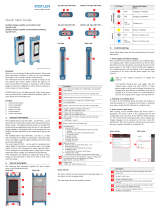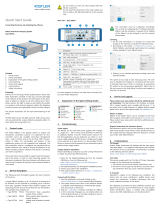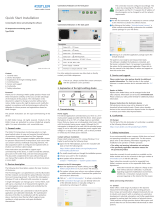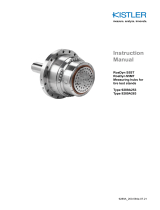Page is loading ...

Instruction
Manual
9813C_002-952e-10.23
KiRoad Wireless
HDR
for RoaDyn S6
Wheel force
transducers
On-board Unit
Type 9813C...
Wheel Unit
Type 9822A...
Rotary Encoder
Type 5262A...


Page 19813C_002-952e-10.23
The information in this manual is subject to change without
notice. To keep pace with technical advancement, Kistler
reserves the right to make improvements and changes
to the product without obligation to notify any person or
organization of such changes.
© 2021 ... 2022 Kistler Group. Kistler Group products are
protected by various intellectual property rights. For more
details visit www.kistler.com. The Kistler Group includes
Kistler Holding AG and all its subsidiaries in Europe, Asia,
the Americas and Australia.
Kistler Group
Eulachstrasse 22
8408 Winterthur
Switzerland
Tel. +41 52 224 11 11
info@kistler.com
Kistler Instrumente GmbH
Business Unit Vehicle Testing
Umberto-Nobile-Str. 14
Germany
Tel. +49 7031 3090 0
info.de@kistler.com
www.kistler.com
Foreword
Foreword

KiRoad Wireless HDR, Type 9813C... and Type 9822A...
9813C_002-952e-10.23Page 2
Contents
1. Introduction .................................................................................................................................4
2. Important notes ...........................................................................................................................5
2.1 For your safety ....................................................................................................................5
2.2 Disposal instructions for electrical and electronic equipment .............................................6
2.3 Handling of Wheel Units .....................................................................................................7
2.4 Software upgrades and updates .......................................................................................10
3. Product description ..................................................................................................................11
3.1 Overview ...........................................................................................................................11
3.2 System overview ..............................................................................................................12
3.3 Accessories ......................................................................................................................13
3.4 Further documents ...........................................................................................................14
4. Technical data ...........................................................................................................................15
........................................................................15
....................................................................16
4.3 RF power transmission .....................................................................................................16
5. Installation and connections....................................................................................................17
5.1 Description of the Wheel Unit and overview of the LED codes ........................................17
5.2 Description of the On-board Unit ......................................................................................21
6. Commissioning .........................................................................................................................22
6.1 Charging the Wheel Unit ..................................................................................................22
6.2 Installing and adjusting the rotary encoder on the vehicle ................................................25
6.3 Installation of the On-board Unit .......................................................................................30
6.4 Connecting to the network ................................................................................................31
6.5 System setup using KiCenter ...........................................................................................32
6.6 Firmware update ...............................................................................................................44
7. Operation ...................................................................................................................................45
...................................................45
7.2 Preparing a measuring drive ............................................................................................48

Page 39813C_002-952e-10.23
Total pages 55
8. Troubleshooting ........................................................................................................................50
8.1 Cables and power supply .................................................................................................50
8.2 On-board Unit status display and LED ............................................................................50
8.3 Interpretation of the status bits .........................................................................................50
8.4 Software ...........................................................................................................................52
8.5 CAN ..................................................................................................................................52
8.6 Environmental conditions .................................................................................................53
8.7 EMC interference ..............................................................................................................53
8.8 Service ..............................................................................................................................53
9. Other information ......................................................................................................................54
10. EU declaration of conformity ...................................................................................................55

KiRoad Wireless HDR, Type 9813C... and Type 9822A...
9813C_002-952e-10.23Page 4
1. Introduction
Thank you for choosing a Kistler quality product charac-
terized by technical innovation, precision and long life.
Take the time to thoroughly read this instruction man-
ual. It will help you with the installation, maintenance, and
use of this product.
To the extent permitted by law Kistler does not accept any
liability if this instruction manual is not followed or prod-
ucts other than those listed under Accessories are used.
-
ing technology:
Piezoelectric sensors for measuring force, torque,
strain, pressure, acceleration, shock, vibration and
acoustic-emission
Strain gage sensor systems for measuring force and
torque
Piezoresistive pressure sensors and transmitters
Signal conditioners, indicators and calibrators
Electronic control and monitoring systems as well as
Kistler also develops and produces measuring solutions
-
ing, plastics and biomechanics sectors.
Our product and application brochures will provide you
with an overview of our product range. Detailed data
sheets are available for almost all products.
If you need additional help beyond what can be found
either on-line or in this manual, please contact Kistler's
extensive support organization.

Important notes
Page 59813C_002-952e-10.23
2. Important notes
2.1 For your safety
Observe the following remarks before you commission
the device. Kistler accepts no responsibility for damages
that could arise from improper use of this product.
Prerequisite for the proper and safe use of the device is
that it is correctly stored, professionally installed and com-
missioned, as well as operated as intended and carefully
maintained.
Only persons who are familiar with the installation, com-
missioning, operation and maintenance of comparable
the given task may work with the device.
Mounting a device on the outside of the vehicle may inval-
idate the general operating permit of the vehicle for use
on public roads. Observe the relevant legal requirements!
Risk of injury!
Do not mount the KiRoad Wireless On-board Unit, mon-
into contact with the airbag in the event of air bag deploy-
ment.
other item is placed in the passenger seat, deactivate the
air bag to prevent accidental contact with the airbag in
the event of air bag deployment.
Equipment must be mounted firmly and securely. Make
sure that the device is placed and secured in such a way
that it cannot slip or fall down.
Improper use or mounting of the equipment may affect
the safety of the vehicle and/or occupants. The equip-
ment must not be mounted and/or operated in any way
that may compromise vehicle and/or occupant safety.

KiRoad Wireless HDR, Type 9813C... and Type 9822A...
9813C_002-952e-10.23Page 6
Do not use defective or damaged equipment, compo-
nents and/or accessories.
Do not modify or change the equipment or its accesso-
ries in any way.
Always observe the correct operating voltages when
The surface temperature of the device can be
above 60 °C during operation.
Do not touch the device during operation. After
switching off, check the temperature before
touching the device.
Use only original equipment, components and/or acces-
sories included in the scope of delivery.
We recommend using only the cables included in the
scope of delivery. If you think it is necessary to use your
own cables, take special note of the correct pin assign-
ment.
Kistler assumes no liability for damages caused due to
the use of cables other than those delivered by Kistler.
For additional information, please contact Kistler:
+49 7031 3090 0
info.de@kistler.com
2.2 Disposal instructions for electrical and electronic equipment
Do not dispose of old electronic instruments in municipal
trash. For disposal when the product has come to the
end of its service life, please return it to an authorized lo-
cal electronic waste disposal service or contact the near-
est Kistler Instrument sales office for return instructions.

Important notes
Page 79813C_002-952e-10.23
2.3 Handling of Wheel Units
The Wheel Units are equipped with a built-in, high-
performance battery with a capacity of 6.5 Ah.
2.3.1 Further documents
UL (Underwriters Laboratories Inc.):
Standard for Lithium Batteries
UL 1642 - Fifth Edition, March 2012
UN (United Nations):
UN Recommendations on the Transport of Dangerous
Goods; Model Regulations.
UN Recommendations on the Transport of Dangerous
Goods; Manual of Tests and Criteria; Part III, sub-sec-
tion 38.3.
IEC (International Electrotechnical Commission):
IEC 61960-3 Secondary cells and batteries containing
alkaline or other non-acid electrolytes - Secondary lith-
ium cells and batteries for portable applications - Part:
3 – Prismatic and cylindrical lithium secondary cells
and batteries
IEC 60079-0 Electrical apparatus for explosive gas
atmospheres, General requirements
IEC 60079-11 Explosive atmospheres – Part 11:
Equipment protection by intrinsic safety "i"
IEC 62133-2 Secondary cells and batteries containing
alkaline or other non-acid electrolytes – Safety require-
ments for portable sealed secondary cells, and for
batteries made from them, for use in portable applica-
tions - Part 2: Lithium systems.
2.3.2 Storing the Wheel Units
Self discharge
temperature of 20 °C is less than 5 %, with a charge level
between 15 and 50 %.
Storage temperature
The recommended storage temperature is between 15 °C
and 30 °C without direct sunlight in a dry, clean, well-
ventilated place.

KiRoad Wireless HDR, Type 9813C... and Type 9822A...
9813C_002-952e-10.23Page 8
Storage outside of these temperatures can lead to a
greater amount of self discharge, lower performance and
swelling of the battery cells.
Minimum charge level during storage
A minimum charge level of 3.62 V at the end of storage is
necessary to prevent deep discharge.
the battery!
If the battery voltage is low or even 0 V after storage, the
battery must be charged as quickly as possible to avoid
the voltage of one or more cells falling below a level
where the cell can be damaged.
To do this, "wake up" the battery by connecting the
supplied charging device.
When the battery receives no charge, it is likely that the
voltage in one or more cells has fallen below the voltage
level below which it is prohibited from accepting a charge
for safety reasons. Because of this, the electronic protec-
tion circuit is activated and inhibits further charging.
If the battery is to be stored for more than 3 months to
less than one year, proceed as follows:
Regular monitoring of the battery voltage, at least
once every 6 months
If necessary: Charge the battery up to 50 % of its
capacitance

Important notes
Page 99813C_002-952e-10.23
2.3.3 Using the Wheel Units after a long storage period
After a long storage period, the following procedure is rec-
ommended:
Complete discharging of the battery
Preferably, run a complete charge / discharge cycle.
Otherwise, it may take 2 to 3 cycles until the maximum
capacitance is available again
Completely charge the battery
2.3.4 Safety information
Do not dismantle the battery
Do not short circuit it
Do not drop or hit it forcibly
Only charge it with the original charging device
2.3.5 Transporting the Wheel Units
Legal conditions
Due to the lithium ion battery installed, the wheel units
must be shipped as hazardous materials. The UN number
UN 3481 applies.
Units for transport must satisfy all of the requirements,
including, but not limited to, special requirements, pack-
aging regulations, labeling and training.
Overview
Individuals who prepare Wheel Units for transport must
specify the applicable measures and instructions care-
fully. Additional information on this can be found in the
http://www.unece.org/trans/danger/danger.html

KiRoad Wireless HDR, Type 9813C... and Type 9822A...
9813C_002-952e-10.23Page 10
Among other things, the following shall be taken into con-
sideration:
The country of origin and destination
The applicable UN code UN 3481 and the corre-
sponding designation "lithium ion battery packaged in
equipment"
Shipping by air
PI 967, UN 3481, Class 9, Part 1 applies to the individual
wheel unit
Max. PAX: 5 kg per package, weight indication exclu-
sive weight of the equipment
Max. CAO: 35 kg per package, weight indication
exclusive weight of the equipment
AWB required
DGD required
Strong outer packaging, no model
IMP Code: RLI
NOTOC required
2.4 Software upgrades and updates
Kistler may occasionally supply upgrades or updates for
embedded software. Such upgrades or updates must
always be installed.
Kistler declines all liability for any direct or consequential
damages caused by products running on embedded soft-
ware that has not been upgraded or updated to the latest
available version.

Product description
Page 119813C_002-952e-10.23
3. Product description
3.1 Overview
The KiRoad Wireless HDR On-board Unit serves as
access point for up to four KiRoad Wireless HDR
Wheel Units, Type 9822A..., and enables measure-
ment data to be output to the connected data acquisition
device. The connected RoaDyn wheel torque transduc-
ers automatically log on and identify themselves after the
-
tion is automatically read into the device so that the sys-
tem is quickly ready for operation without additional user
action. The signal is output to the data acquisition system
-
triggered using the remote control or via Ethernet or USB
from the laptop or PC using the KiCenter software.
The Wheel Unit including exchangeable accumulator bat-
tery, the rotary encoder for trecording the angle and the
Since each KiRoad Wireless HDR system sets up its
own encrypted WLAN network, several KiRoad Wireless
systems can operate simultaneously without interference,
e.g. several vehicles each equipped with 4 RoaDyn trans-
ducers.
If a Kistler DTI-Logger is used for data acquisition, only
one cable is required for the On-board Unit to transfer the
via KiCenter. Otherwise, the CAN signals and analog
friendly via KiCenter using Ethernet or USB. All transmit-
ted measurement data can be viewed in KiCenter.

KiRoad Wireless HDR, Type 9813C... and Type 9822A...
9813C_002-952e-10.23Page 12
Fig. 1: KiRoad Wireless HDR system components
On-board Unit Wheel Unit RoaDyn WFT Rotary Encoder
3.2 System overview
Fig. 2: KiRoad Wireless HDR system

Product description
Page 139813C_002-952e-10.23
3.3 Accessories
3.3.1 Included accessories Wheel Unit
Component Ordering No.
18043616
3.3.2 Optional accessories Wheel Unit
Component Ordering No.
Exchangeable accumulator battery incl. charging tray, charging device
and mains cable EU
18044044
Exchangeable accumulator battery 18044086
Charging tray, charging device and mains cable EU 18044087
3.3.3 Included accessories On-board Unit
Component Ordering No.
Cable: CAN connection cable 55155606
Cable: Ethernet 55155608
Cable: USB 55155609
Connection cable for OBU/DT5302
Power cable 4P DT5302
Ethernet cable 8P DT5302 connection cable for OBU/DT5302
55156522
55156523
55158080
55157368
USB Memory stick 8 GB 22000444
Transport case Peli Storm Case iM2750 with inlay 55250671
3.3.4 Optional accessories On-board Unit
Component Ordering No.
Cable: Analog Output 55159949
Rod antenna, 2.4GHz, with 3m cable 55269688

KiRoad Wireless HDR, Type 9813C... and Type 9822A...
9813C_002-952e-10.23Page 14
3.3.5 Included accessories Rotary encoder
Component Ordering No.
Type 9711A4 for CFRP wheel force transducers
Type 9711A5 for ALU wheel force transducers
Customized
Rotary encoder
Angle encoder
Angle disk / insulating disk with spacer sleeves
Pincer clamp
Customized
Wheel mounting bolts Customized
Spacers in different sizes
mm: 10 / 20 / 30 / 40 / 50 / 60 55232316
3.3.6 Optional accessories rotary encoder
Component Ordering No.
Centering sleeve
Insulating disk
Customized
3.4 Further documents
002-982e – KiRoad Wireless HDR Quick Start Guide
002-609e – KiCenter Installationsanleitung

Technical data
Page 159813C_002-952e-10.23
4. Technical data
4.1 Specications Wheel Unit, Type 9822A...
System specifications
mm 184x184x62,8
Weight kg 0,8
Temperature range
Operation °C –20 ... 50
Storage °C –40 ... 50
Power supply lithium-Ion accumulator battery
Number of load cycles >500
Wireless standard IEE 802.11n
Transmitted channels
Forces Fx, Fy, Fz
Torques Mx, My, Mz
Battery voltage Vbat
Resolution Bit 16
Sampling rate
Signals forces / torques Hz 1 000
Vbat Hz 10
Battery operating time
@+20 °C h >5
@–20 °C h >4
Latency of data transmission ms 538

KiRoad Wireless HDR, Type 9813C... and Type 9822A...
9813C_002-952e-10.23Page 16
4.2 Specications On-board Unit, Type 9813C...
System specifications
mm 181x125x149
Weight grams 2,500
Operating temperature range °C –20 ... 50
IP40
Power supply VDC 10 ... 28
Power consumption max. W 17
Wireless standard IEEE 802.11n
Data outputs
Digital output – CAN
CAN Bus – 2 nodes 2.0B
Baud rate MBd 0.125 ... 1
Bit 16
Digital output – DTI
Bit 16
Output range V
Resolution Bit 16
2.0
Ethernet TCP/IP yes
Transmitted channels
Forces Fx, Fy, Fz
Torques Mx, My, Mz
Battery voltage Vbat
4.3 RF power transmission
Wireless output power as combined power of all chains in

Installation and connections
Page 179813C_002-952e-10.23
5. Installation and connections
5.1 Description of the Wheel Unit and overview of the LED codes
Fig. 3: KiRoad Wireless HDR Wheel Unit
1
2
1Initialization switch
2Indicator LEDs
Each LED on the control panel represents a wheel posi-
-
below, refer to the list of error LED patterns on page 19.
Fig. 4: Explanation LED patterns
is used to control the Wheel Unit. While the switch is
-

KiRoad Wireless HDR, Type 9813C... and Type 9822A...
9813C_002-952e-10.23Page 18
<2 s Initialization:
Measurement: -
-
er-on.
This functionality is disabled during steps 1 ... 3 of the positioning process.
>2 s Activate the positioning procedure to pair the Wheel Unit with an OBU and to assign the posi-
tion number. The positioning procedure is described on the next page. Make sure that the
OBU is in positioning mode!
>7 s
LED operating status
1
2
3
Sequence in normal operation
1. All LEDs o:
The Wheel Unit is not supplied with power. Turn the unit on by pressing
the button in the center of the control panel.
2. All LEDs on:
After power-on, all LEDs light up while the Wheel Unit performs its basic
3. All LEDs ash slowly:
Basic initialization completed. Waiting for the end of the WLAN module
boot phase.
4. 1 LED wave (1►2►3►4►3►2, ⟲):
WLAN module initialized. Connection to the OBU and request of the
position. If the wheel unit has not yet been paired with an OBU, the
initialization process is aborted here. In this case start the positioning
process as explained on the next page.
5. 1 LED on (e.g. LED 3):
The corresponding LED lights up for 3 ... 5 seconds.
6. 1 LED flashes (e.g. LED 3):
The Wheel Unit is connected, the data measurement is running. A LED
flashes every 3 seconds. The flashing LED represents the assigned
Steps 1 ... 5 are called "initialization phase". Step 6 is called the "measurement phase".
It is recommended to wait until step 4 before starting the positioning process.
/









